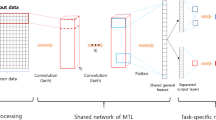Abstract
Intelligent Prognostics and Health Management (PHM) technology aims to estimate the Remaining Useful Life (RUL) of a subsystem or a component using data collected by sensors. The rise in the complexity of systems requires new models to capture the relationship between the sensors and the RUL. Novel deep Convolutional Neural Networks (CNN) have been proposed as an approach for estimating the RUL. However, large amount of data is needed to use Machine Learning (ML) techniques. We explore current ML methods being used with different types of datasets and provide a conclusion on deciding what learning method works best with unique datasets. We find that, for most systems, the ML method used highly depends on the dataset and can greatly decrease the cost and increase the reliability.
Access this chapter
Tax calculation will be finalised at checkout
Purchases are for personal use only
Similar content being viewed by others
References
Orsagh, R., Brown, D., Kalgren, P., Byington, C., Hess, A., Dabney, T.: Prognostic health management for avionic systems. In: 2006 IEEE Aerospace Conference (2006)
Sankavaram, C., Pattipati, B., Kodali, A., Pattipati, K., Azam, M., Kumar, S., Pecht, M.: Model-based and data-driven prognosis of automotive and electronic systems. In: 2009 IEEE International Conference on Automation Science and Engineering (2009)
Muller, A., Suhner, M.-C., Iung, B.: Formalisation of a new prognosis model for supporting proactive maintenance implementation on industrial system. Reliab. Eng. Syst. Saf. 93(2), 234–253 (2008)
Dumargue, T., Pougeon, J.-R., Massé, J.-R.: An approach to designing PHM systems with systems engineering, June 2016
Yan, J.: Machinery Prognostics and Prognosis Oriented Maintenance Management. Wiley-Blackwell, Chichester (2015)
Barton, P.H., Ogden, R.: Stirling cryocooler prognostics and health management (PHM). In: 2009 IEEE AUTOTESTCON (2009). https://doi.org/10.1109/autest.2009.5314024
Sutharssan, T., Stoyanov, S., Bailey, C., Yin, C.: Prognostic and health management for engineering systems: a review of the data-driven approach and algorithms. J. Eng. 2015(7), 215–222 (2015)
Benner, C.L., Peterson, R.A., Russell, B.D.: Application of DFA technology for ımproved reliability and operations. In: 2017 IEEE Rural Electric Power Conference (REPC) (2017)
Data Catalog: Data.gov. https://catalog.data.gov/dataset/c-mapss-aircraft-engine-simulator-data-d8ed0. Accessed 27 Nov 2019
Xu, J., Wang, Y., Xu, L.: PHM-oriented integrated fusion prognostics for aircraft engines based on sensor data. IEEE Sens. J. 14(4), 1124–1132 (2014)
Rumelhart, D.E., Hinton, G.E., Williams, R.J.: Learning representations by back-propagating errors. In: Anderson, J.A., Rosenfeld, E. (eds.) Neurocomputing: Foundations of Research, pp. 696–699. MIT Press, Cambridge (1988)
Bektas, O., Marshall, J., Jones, J.A.: Comparison of computational prognostic methods for complex systems under dynamic regimes: a review of perspectives. In: Archives of Computational Methods in Engineering, July 2019
Zhang, C., Sun, J.H., Tan, K.C.: Deep belief networks ensemble with multi-objective optimization for failure diagnosis. In: 2015 IEEE International Conference on Systems, Man, and Cybernetics (2015)
Babu, G.S., Zhao, P., Li, X.-L.: Deep convolutional neural network based regression approach for estimation of remaining useful life. In: Database Systems for Advanced Applications Lecture Notes in Computer Science, pp. 214–228 (2016)
Heimes, F.O.: Recurrent neural networks for remaining useful life estimation. In: 2008 International Conference on Prognostics and Health Management (2008)
Li, X., Ding, Q., Sun, J.-Q.: Remaining useful life estimation in prognostics using deep convolution neural networks. Reliab. Eng. Syst. Saf. 172, 1–1 (2018)
Li, X., Zhang, W., Ding, Q.: Deep learning-based remaining useful life estimation of bearings using multi-scale feature extraction. Reliab. Eng. Syst. Saf. 182, 208–218 (2019)
Carroll, J., Koukoura, S., Mcdonald, A., Charalambous, A., Weiss, S., Mcarthur, S.: Wind turbine gearbox failure and remaining useful life prediction using machine learning techniques. Wind Energy 22(3), 360–375 (2018)
Xue, X., Hu, Y., Qi, S.: Remaining useful life estimation for proton exchange membrane fuel cell based on extreme learning machine. In: 2016 31st Youth Academic Annual Conference of Chinese Association of Automation (YAC) (2016)
Nash, W., Drummond, T., Birbilis, N.: A review of deep learning in the study of materials degradation. npj Mater. Degrad. 2(1) (2018)
Gibert, X., Patel, V.M., Chellappa, R.: Material classification and semantic segmentation of railway track images with deep convolutional neural networks. In: 2015 IEEE International Conference on Image Processing (ICIP) (2015)
Gibert, X., Patel, V.M., Chellappa, R.: Deep multitask learning for railway track inspection. IEEE Trans. Intell. Transp. Syst. 18(1), 153–164 (2017)
Petricca, L., Moss, T., Figueroa, G., Broen, S.: Corrosion detection using A.I: a comparison of standard computer vision techniques and deep learning model. In: Computer Science & Information Technology (CS & IT) (2016)
Author information
Authors and Affiliations
Corresponding author
Editor information
Editors and Affiliations
Rights and permissions
Copyright information
© 2021 Springer Nature Switzerland AG
About this paper
Cite this paper
Lemus, C., Latifi, S. (2021). Using Machine Learning Techniques to Estimate the Remaining Useful Life of a System with Different Types of Datasets. In: Selvaraj, H., Chmaj, G., Zydek, D. (eds) Proceedings of the 27th International Conference on Systems Engineering, ICSEng 2020. ICSEng 2020. Lecture Notes in Networks and Systems, vol 182. Springer, Cham. https://doi.org/10.1007/978-3-030-65796-3_13
Download citation
DOI: https://doi.org/10.1007/978-3-030-65796-3_13
Published:
Publisher Name: Springer, Cham
Print ISBN: 978-3-030-65795-6
Online ISBN: 978-3-030-65796-3
eBook Packages: Intelligent Technologies and RoboticsIntelligent Technologies and Robotics (R0)




